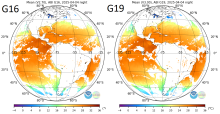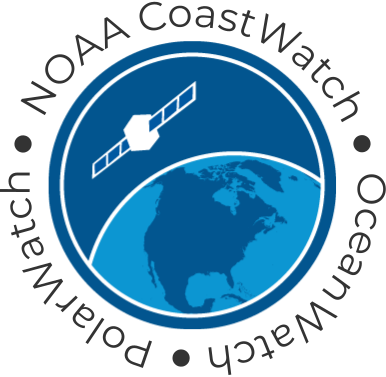| Date |
April 16, 2025
|
|---|---|
| Content Type |
Announcement
|
| Author(s) | |

|
The STAR SST science team has been monitoring the quality of ACSPO SST from Goes-19 ABI after the drift to the East position. Based on G19 data between April 2-11, no evidence of degradation of the ACSPO SST data post-drift has been seen. The figure shows a comparison of G16 and G19 ACSPO SST from April 4 when both were in the same East position.
Based on our analysis of post-drift ACSPO G19 SST (agreement with G16 SST, in-situ SST, and various L4 SST products), we have determined that the G19 SST data quality is ready for experimental, best effort, public distribution.
The G19 SST data on CoastWatch is produced using ACSPO V3.00 while the previous G16 data was produced using V2.70. The main updates for geostationary satellites between V2.70 and V3.00 are:
- Misclassification of cold SST features as clouds has been reduced in V3.00 compared to V2.70. Users should expect more complete SST coverage in dynamic SST regions, especially on the cold side of thermal fronts in the Gulf Stream and Brazil Current.
- V2.70 G16 ABI SST was biased about -0.10 K cold due to drift in the G16 ABI calibration since the V2.70 SST retrieval coefficients were trained in 2018. The V3.00 G19 ABI SST algorithm was trained on recent in-situ SST data and is therefore about 0.1 K warmer than G16 on average.
For more information on the ACSPO V3.00 algorithm, see the ACSO Algorithm Theoretical Basis Document (ATBD) at https://coastwatch.noaa.gov/pub/socd2/coastwatch/sst/documents/ACSPO_SST_ATBD_v2p00.pdf
The ACSPO V3.00 is capable of producing G19 SST data and was delivered to ASSISTT (for transition to operations) last January. ASSISTT is still working on packaging the code and we expect it to be running in operations later this year. In the meantime, best effort ACSPO V3.00 G19 SST is being run in NESDIS/STAR and distributed through CoastWatch. Link to CoastWatch ACSPO SST ABI data page is here. We will also work with PO.DAAC on archival and distribution.
Note that the current G19 SST data is produced using SST retrieval coefficients (lookup tables) computed from G19 data in the pre-drift position. Over the next few months we will collect matchups between satellite and in-situ SST data and update the lookup tables. We expect SST quality to improve with the new lookup table but we emphasize that the current SST quality is still high-quality and is fit for both operational and research purposes.
